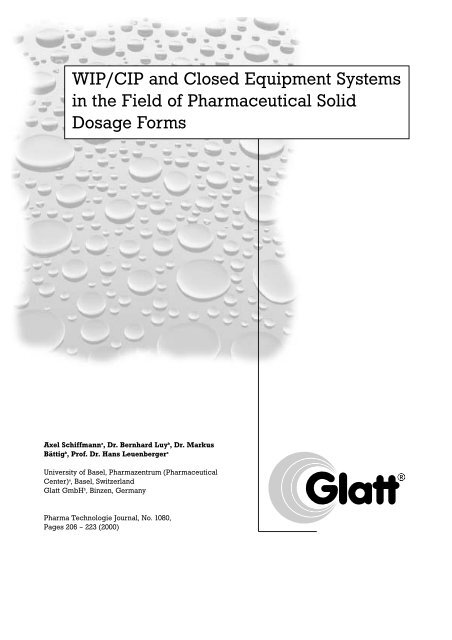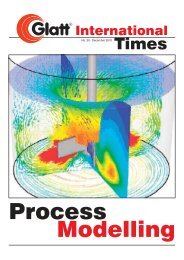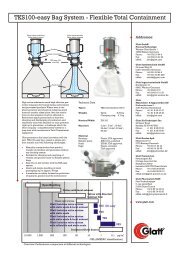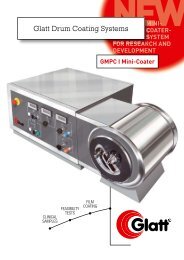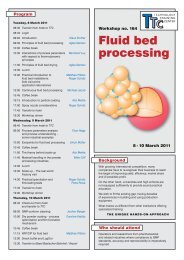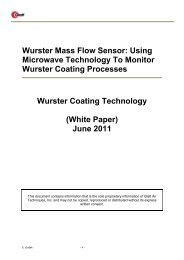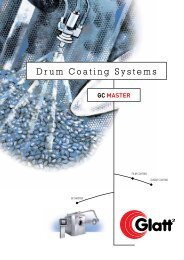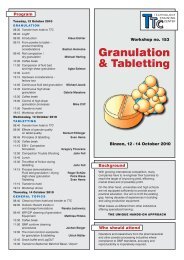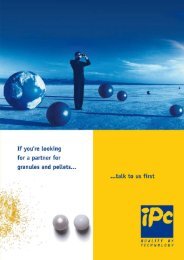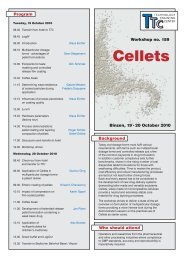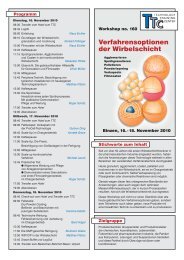Sonderdruck WIP / CIP - Glatt
Sonderdruck WIP / CIP - Glatt
Sonderdruck WIP / CIP - Glatt
You also want an ePaper? Increase the reach of your titles
YUMPU automatically turns print PDFs into web optimized ePapers that Google loves.
<strong>WIP</strong>/<strong>CIP</strong> and Closed Equipment Systems<br />
in the Field of Pharmaceutical Solid<br />
Dosage Forms<br />
Axel Schiffmann a , Dr. Bernhard Luy b , Dr. Markus<br />
Bättig b , Prof. Dr. Hans Leuenberger a<br />
University of Basel, Pharmazentrum (Pharmaceutical<br />
Center) a , Basel, Switzerland<br />
<strong>Glatt</strong> GmbH b , Binzen, Germany<br />
Pharma Technologie Journal, No. 1080,<br />
Pages 206 – 223 (2000)
Summary:<br />
<strong>WIP</strong>/<strong>CIP</strong> and Closed Equipment Systems in the Field of Pharmaceutical Solid Dosage Forms<br />
In the pharmaceutical industry production equipments of the manufacture of solid dosage forms are<br />
cleaned manually, semi- or fully-automated. In order to implement a fully automated cleaning process<br />
which meets pharmaceutical (i.e. GMP-) requirements, many conventionally used components must be<br />
changed considerably with respect to construction and design. An important aspect is the so-called<br />
Total Containment: <strong>CIP</strong>-ability and Total Containment are interdependent and must be considered<br />
equally with the development. The realisation of the Total Containment is an absolute prerequisite for<br />
the implementation of this new type of equipment. By the example of a fluid bed system this article describes,<br />
how this can be achieved by modifications of conventional equipments and of peripheral devices.<br />
The abbreviations <strong>WIP</strong>/<strong>CIP</strong> used in this context are clearly defined. <strong>WIP</strong> (washing in place) means<br />
semi- or fully-automated cleaning with either undefined result of cleaning or with the result that the<br />
system is not yet clean according to GMP-requirements. <strong>CIP</strong> (cleaning in place), on the other hand,<br />
stands for the entire process of a fully-automated cleaning to a GMP-conform level, including all factors,<br />
which have influence on the cleaning result. This includes the proof that the acceptance criterion of<br />
the cleaning validation was achieved.<br />
A comparison study between the manual and fully-automated cleaning shows that by systematic modification<br />
of the individual components in connection with a fully-automated cleaning program a higher<br />
cleaning grade can be achieved. Furthermore, a statement about the reproducibility of cleaning success<br />
can be met.<br />
2<br />
Keywords<br />
� Equipment systems, containment<br />
� Cleaning in place<br />
� Pharmaceutical solid dosage forms<br />
� Good Manufacturing Practice<br />
� Washing in place
1. Introduction<br />
In past years, increasing attention has been directed to the cleaning of processing systems and the<br />
corresponding cleaning validation, both by pharmaceutical companies as well as by monitoring<br />
authorities. There are several important reasons for this.<br />
On the one hand, one seeks to lower the risk of cross-contamination for existing products and<br />
production lines. And on the other, highly effective materials are becoming increasingly more<br />
prevalent in production and manufacturing. For some time now, these materials have placed high<br />
demands on cleaning and, in general, have required - in as far as has been possible – a dust-free,<br />
closed manufacturing process (e.g., cytostatic agents, hormones, cardiac glycosides, etc.). Exposure of<br />
the operating staff, environmental protection and safety aspects provide additional reasons to employ<br />
completely closed production lines whenever possible, as is carried out under Total Containment.<br />
Additional factors that must be considered are economic aspects as well as the specific requirements<br />
for the cleaning validation. Idle times, no matter what their reasons, are unproductive. With the<br />
constantly increasing awareness of costs, manual cleaning procedures that are staff-intensive and are<br />
time-consuming are being critically compared to automated cleaning procedures that, whenever<br />
possible, are carried out at night. Another advantage is that, with automated cleaning in closed<br />
systems, fundamentally more aggressive cleaning conditions (detergent types and concentrations,<br />
temperatures, pressures, etc.) can be used than those that are employed with traditional methods.<br />
With regard to validation issues, the reproducibility of an automated cleaning has certain advantages<br />
when compared to manual hand cleaning. Parameters that are relevant for cleaning tend to be more<br />
readily accessible and easier to record and document, thereby facilitating validation. Considering<br />
these aspects, an automated cleaning system offers clear advantages.<br />
2. <strong>WIP</strong> / <strong>CIP</strong> Terminology<br />
Systems that are very different, even from their stated goal, are frequently lumped together under the<br />
same <strong>CIP</strong> (cleaning in place) designation. The description, <strong>CIP</strong> Process, already well-ensconced in the<br />
liquids sector where it is used in the more narrow sense of the word, has been adapted to use in the<br />
solid forms sector.<br />
But which systems in this latter sector actually carry out a <strong>CIP</strong> process? Installing one or more<br />
cleaning nozzles in a processing system, e.g., such as in a fluid bed apparatus that has a conventional<br />
construction, may be designated as a <strong>CIP</strong> system. Nevertheless, it certainly does not compose a<br />
system that is clean enough, according to a truly fully-automated, validated cleaning based on GMP<br />
standards, that would enable the processing of a formulation with another active agent. Based on these<br />
reasons, and especially with conventionally designed systems, the corresponding cleaning systems<br />
have been designated <strong>WIP</strong> (washing in place) systems. Here, a good - or even a very good -<br />
pre-cleaning is achieved; however, this must always be followed by additional manual cleaning steps.<br />
Even when a solid dosage form production system is set up for optimal cleanability and has the<br />
corresponding peripheral devices, one can only speak of a system with <strong>CIP</strong> cleaning in the GMP sense<br />
if, in addition to the system design, the respective product, the manufacturing process and the cleaning<br />
procedures are also known. Even though in some cases, system manufacturers can claim<br />
<strong>CIP</strong>-compatibility, the following must be considered:<br />
One particular system that has proven to be <strong>CIP</strong>-compatible for a certain product may not be<br />
<strong>CIP</strong>-compatible for a different product. The system itself can only be laid out for the best possible<br />
cleaning, but the actual degree of cleaning achievable must always be determined in each individual<br />
case.<br />
3
3. Design and Technology Requirements<br />
Even while a multitude of processes with correspondingly different processing technology are<br />
employed in solid dosage form technology, the critical design principles and design characteristics of<br />
the different apparatuses are the same with regard to their cleaning and containment aspects. Flange<br />
joints, sensors, unions, viewing ports, filter media with air or gas carrying apparatuses, etc. must be<br />
employed throughout the system and product transfer executed. Using fluid bed technology as an<br />
example, we aim to demonstrate how the requirements for cleanability and finished product handling<br />
can be met and implemented.<br />
3.1. <strong>WIP</strong> Cleaning<br />
With fluid bed systems having a traditional design, certain components are not suitable, even<br />
from the start, for a completely automated, GMP-conforming <strong>CIP</strong>; therefore, only a <strong>WIP</strong> process<br />
can even be considered.<br />
This will be demonstrated using the example of some of the system parts found in a fluid bed<br />
apparatus.<br />
3.1.1. Seals and Gaskets<br />
These are usually found at flange joints<br />
(Figs. 1 and 2), sight glasses, sensors, nozzle<br />
flanges and blind flanges on nozzle connection<br />
pieces, etc. Even here it must be kept in<br />
mind that, in addition to the solid ingredient,<br />
solutions or suspensions that arise from wet<br />
cleaning can also enter into the sealing system.<br />
In addition to the actual cleaning (i.e., including<br />
the removal of such fluids), the drying of these<br />
types of sites is important in order to prevent<br />
microbial growth, wherever and whenever<br />
possible.<br />
3.1.2. Bottom Screen of the Product Container<br />
A multi-layered design consisting of a supporting<br />
floor is frequently used. On top of this is placed<br />
a (fine) sieve mesh and a stabilizing construction<br />
that eases the strain on the fine sieve. This set-up<br />
must be manually dismantled and each part<br />
must be individually cleaned in order to remove<br />
those particles that have found their way in<br />
between the layers (Fig. 3).<br />
Fig. 2: A conventionally-designed flange. With this<br />
shape, either the product or the cleaning compound can<br />
infiltrate into the seal.<br />
4<br />
Fig. 1: A conventionally-designed blind flange. When<br />
the seal is positioned as shown, the product can accumulate<br />
in the gap.<br />
Fig. 3: A conventionally-constructed bottom screen<br />
(multi-layer mesh construction)
3.1.3. Sensors<br />
Particularly important to mention in this regard<br />
are those instruments used to measure temperature<br />
and sites where pressure differences are recorded.<br />
Especially when measuring pressure differences,<br />
a direct, open connection exists between the<br />
measuring site (e.g., directly in the product space)<br />
and the pressure transmitter. Cleaning solutions<br />
can infiltrate these sites and, therefore, a hand<br />
cleaning is almost always necessary.<br />
3.1.4. Product Filters<br />
As a rule, these textile filters are usually in the<br />
shape of bag filters that can be shaken or blown<br />
out (Figs. 4 and 5). For <strong>WIP</strong> cleaning, one can<br />
first carry out a pre-wash in the system; this helps<br />
avoid excessive dust formation during removal<br />
from the system. Subsequently, a cleaning in<br />
the washing machine takes place while the<br />
rest of the system is further cleaned. These<br />
filters are very frequently dedicated equipment.<br />
An (economically sound) <strong>CIP</strong> cleanability can<br />
usually be excluded because of the types of<br />
attachments (such as a clamped flange joint<br />
or similar attachment). Specifically, cleaning<br />
liquids containing dissolved or suspended<br />
agents are transported via capillary forces to<br />
sites from which their removal proves most<br />
difficult.<br />
3.2. <strong>CIP</strong> Cleaning<br />
In order to achieve the stated goal of having an<br />
optimal fluid bed apparatus that can be cleaned<br />
without any manual action and which, additionally,<br />
adheres to a Total Containment concept, one sees<br />
that it is not only the main components that must<br />
be critically examined, and if necessary, modified,<br />
but also each small detail, no matter how minute,<br />
from the charge ports over the sensors and the<br />
viewing ports up to the cleaning nozzles themselves.<br />
Indeed, for setting up the best possible GMP-conforming<br />
<strong>CIP</strong> for fluid bed systems, the following modifications<br />
must be carried out in the various system parts:<br />
3.2.1. Flange Connections, Sealing Systems<br />
To make <strong>CIP</strong> cleaning possible here, a sealing system was developed which, in the beginning, does not<br />
permit the product or the cleaning fluid to enter the flange system at all (Figs. 6 and 7). This is achieved<br />
by a correspondingly milled flange in combination with inflatable or mechanically expanding seals<br />
which reliably prevent any escape from the inside of the container. The seal is placed in an exposed<br />
location, i.e., even though it is in direct contact with the product, it nevertheless guarantees a free<br />
inflow and outflow of the cleaning liquids) during <strong>CIP</strong> cleaning. This is also important with regard to<br />
drying, which is only efficient in a free flow-through system.<br />
5<br />
Fig. 4: Conventional bag type shaking filters<br />
Fig. 5: Conventional pleated filter cartridge with a laminated<br />
PTFE membrane.
Fig. 6: Example of a transition junction on a <strong>CIP</strong>–conforming<br />
system (<strong>Glatt</strong>, Binzen).<br />
Viewing ports/blind flanges, etc.<br />
Ideally, the viewing ports are solidly built into the system (Figs. 8 and 9). The welded construction thus<br />
ensures a smooth and flat surface.<br />
Fig. 8: Welded-in viewing port, <strong>CIP</strong>-design, after contamination<br />
(view from the product side) (<strong>Glatt</strong>, Binzen).<br />
6<br />
Fig. 7.- Inflatable seal, <strong>CIP</strong>-capable, in the sealed condition<br />
(view from the inside of the container) (<strong>Glatt</strong>,<br />
Binzen).<br />
Fig. 9: Viewing port of a conventional design (<strong>Glatt</strong>,<br />
Binzen).<br />
With exchangeable flange systems, the seal should be exposed in direct contact with the product and<br />
easily positionable.<br />
Both of these conditions have been fulfilled with a special flange design (O-Plus-System, <strong>Glatt</strong>,<br />
Binzen; Figs. 10 and 11). Here, the O-ring is hollow and, using a variable collar, can be held in two positions:<br />
a) In an unloaded condition, a twisting or an incorrect positioning of the seal seat is avoided,<br />
thereby ensuring a facile installation or dismantling of the flange.<br />
b) In the final sealed state; the O-ring is pressed into the proper position.
Fig. 10: <strong>CIP</strong>-compatible blind flange.<br />
(O-Plus System, <strong>Glatt</strong>, Binzen).<br />
3.2.2. Bottom Screen<br />
Instead of the multi-layered construction having a<br />
perforated bottom upon which a fine sieve is placed,<br />
a so-called wedge wire sieve is installed (Figs. 12<br />
and 13). This is a single layer leading bottom which<br />
is completely accessible from both sides for cleaning.<br />
With a defined gap distance (which forms the<br />
free surface), stainless steel rods having a triangular<br />
cross-sectional shape are arranged parallel to each<br />
other. The apex of the triangle thus faces downward<br />
so that, when seen from above, the surface is flat<br />
and smooth.<br />
Basically, other systems might also be suitable, for<br />
example, perforated metal plates with a directed air<br />
flow (e.g., screen mesh pierced sheets, such as<br />
Conidur ® etc.). All floors have the common potential<br />
problem that the product can drop into the lower<br />
part of the system.<br />
As soon as the leading bottom shows openings that<br />
are larger than the smallest particles contained in<br />
the product, the product can fall through. Through<br />
proper process control, even from the charging<br />
stage onwards, this can be reliably prevented as<br />
long as the leading bottoms ensure a sufficient<br />
pressure difference.<br />
7<br />
Fig. 11: Set-up showing the seal installed, <strong>CIP</strong>-compatible<br />
design (O-Plus System, <strong>Glatt</strong>, Binzen).<br />
Fig. 12: <strong>CIP</strong>-compatible wedge wire bottom plate (<strong>Glatt</strong>,<br />
Binzen).<br />
Fig. 13: Cross-section of a wedge wire bottom plate, <strong>CIP</strong>compatible<br />
design (<strong>Glatt</strong>, Binzen).
3.2.3. Sensors<br />
All sensors are installed flush against the wall and do not allow product penetration (Fig. 14).<br />
Temperature sensors are welded in, for example, however, they can still be replaced from the outside<br />
(Fig. 15). When measuring pressure differences, a completely different measuring principle is employed.<br />
An absolute pressure measurement is carried out at the measuring site under consideration. The<br />
specially developed sensor is located behind a ceramic pane which is installed flush against the wall<br />
and sealed with an O-ring. The difference in the absolute pressures is continuously calculated in the<br />
background of the system control and this value is then displayed.<br />
Fig. 14: Pressure sensor, installed in a <strong>CIP</strong>-compatible<br />
construction (<strong>Glatt</strong>, Binzen).<br />
3.2.4. <strong>CIP</strong>-Compatible Filter Cartridge<br />
Stainless steel filters cartridges, having a specific construction<br />
and design for ensuring cleanability and<br />
long-term stability, are used; this is a most important<br />
aspect, especially with regard to wet cleaning.<br />
Pleated filter cartridges have a significant disadvantage<br />
with respect to product accumulation and a corresponding<br />
decrease in the filter surface, accessibility<br />
for the cleaning media as well as long-term stability<br />
with higher blow-out pressures (Figs. 16, 17 and 18).<br />
Fig. 17. Example of a pleated stainless steel filter with a<br />
corresponding supporting mesh. Demonstrates good<br />
mechanical stability, however, product residues are difficult<br />
to remove.<br />
8<br />
Fig. 15: Temperature sensor in the product container,<br />
installed in a <strong>CIP</strong>-compatible construction (<strong>Glatt</strong>,<br />
Binzen).<br />
Fig. 16: Example of a pleated stainless steel filter<br />
without a corresponding support mesh Demonstrates<br />
good cleanability, however, material fatigue arises as a<br />
consequence of the blowing out process.<br />
Fig. 18: Example of a very dirty pleated filter (spray granulation<br />
process). Severe decrease in the filter area on<br />
the product side, experiences considerable cleaning<br />
problems.
Therefore, a round design was developed where the circumference is fixed (unlike the case with pleated<br />
cartridges which experience a significant expansion in their circumference when the pleats are<br />
separated out); this round design is extremely stable (Figs. 19 and 20). This design permits one to use a<br />
special blow out mechanism that allows considerably higher pressures within the cartridge than those<br />
that can be borne by a pleated cartridge, especially with wet cleaning. Due to the capillary forces of<br />
the water with wet cleaning, the sieve material forms a considerably higher resistance than it does in<br />
the dry state.<br />
Fig. 19: Filter housing, <strong>CIP</strong>-compatible design (SC filters,<br />
<strong>Glatt</strong>, Binzen).<br />
Additionally important is that the filtering layer (as<br />
needed, up to 2 µm mesh size of the stainless steel<br />
sieve mesh) comes to lie in a completely external<br />
location and is not covered by an additional outer,<br />
coarser supporting membrane (for stabilization purposes),<br />
as is usually seen with <strong>CIP</strong>-compatible pleated<br />
stainless steel filter cartridges. With a coarser<br />
supporting mesh, the product can actually claw its<br />
way into the filter and even find its way between the<br />
membranes; this poses great difficulty when trying<br />
to remove the product.<br />
With regard to the cleaning validation, it should be<br />
noted that, here, the usual swab tests fail. Thus product<br />
residues present in the filter or supporting<br />
mesh cannot be reached. For the cleaning validation,<br />
it is recommended that, after cleaning, the cartridge<br />
be completely immersed in a corresponding<br />
container using the appropriate solvent and that the<br />
analysis be made from this (Fig. 21). Likewise, the<br />
accumulation of residues should be examined.<br />
9<br />
Fig. 20: Stainless steel filter cartridge. <strong>CIP</strong>-compatible<br />
design (SC filters, <strong>Glatt</strong>, Binzen).<br />
Fig. 21: Example of an immersion tank. With the use of<br />
a displacement body, the required solvent volume is<br />
reduced.
4. Total Containment<br />
Beside the <strong>CIP</strong> compatibility of a system, a completely closed product handling is another essential<br />
part of the total concept. Both aspects complement, respectively, necessitate each other. When compared<br />
to conventional systems, changes in the following areas are necessary in order to achieve containment.<br />
4.1. System Safety Concept<br />
As part of containment, with regard to the outside, a completely closed system design can be achieved<br />
without explosion pressure release. This is achieved by performing 3 or 10 bar pressure surge resistant<br />
executions, depending on the product characteristics (presence of solvent: yes/no).<br />
What is important is the proven reliability (certification by an independent institution) of the chosen<br />
design as well as a corresponding realistic pressure test on the finished single system.<br />
4.2. Charge Ports / Closed Removal<br />
The system must have corresponding set-ups that permit a completely closed handling also to be carried<br />
out here. For example, this can be achieved by the docking of containers and gravity charging;<br />
one alternative would be a possible pneumatic advancement if the housing (-concept) does not permit<br />
charging from the top. Indeed, with the pneumatic feeding, the same <strong>CIP</strong> design requirements that are<br />
found with the fluid bed are also necessary here. The product is transported away from the system via<br />
floor discharge, a closed side removal or again, pneumatic advancement. With respect to seals, cleaning<br />
nozzles, etc., all parts must be designed for fully automated cleaning.<br />
4.3. Cleaning Nozzles<br />
At all relevant locations, the system has self-cleaning cleaning nozzles that remain permanently fixed<br />
to the system but which automatically extend during the cleaning process; subsequently, using compressed<br />
air, they are dried and then again retract to their original position (flush with the wall) (Figs.<br />
22 and 23). Contrary to the usual <strong>WIP</strong> process, no manual action before the cleaning is required (opening<br />
of the dirty system, inserting the <strong>WIP</strong> nozzles), so that here, too, work in an enclosed system is<br />
possible.<br />
Fig. 22: Extendible cleaning nozzles, <strong>CIP</strong>-compatible<br />
design (<strong>Glatt</strong>, Binzen).<br />
10<br />
Fig. 23: Extendible cleaning nozzles (in the retracted<br />
state); as seen from the inside of the container;<br />
<strong>CIP</strong>-compatible design (<strong>Glatt</strong>, Binzen).
5. <strong>CIP</strong> Cleaning Station<br />
For the cleaning itself, there is naturally a corresponding <strong>CIP</strong> preparation system that is necessary.<br />
This system permits the selection of appropriate cleaning parameters and records the required values.<br />
Because various system functions (flaps, valves, heating and fan for drying, etc.) must be controlled<br />
during cleaning, whenever possible, the <strong>CIP</strong> program should be managed by the same system control<br />
that directs the actual manufacturing process.<br />
The cleaning process itself is determined by the:<br />
� various types of cleaning:<br />
a) Lost cleaning – usually as a pre-rinse or post-rinse step: Here the water that is brought into<br />
the processing system flows directly out of the system after it has had contact with the<br />
surface of the system; it is not reused. This ensures that coarse dirt (pre-rinsing step) is<br />
removed, as are tenside residues and/or lime-containing water (as post-rinsing steps).<br />
b) Recirculating cleaning as the main cleaning step. Due to economic reasons, the cleaning<br />
medium is pumped in a cycle.<br />
� Type and concentration of detergents:<br />
Products used include bases, acids, emulsifiers, oxidizing agents, complex-forming agents in<br />
appropriate concentrations.<br />
� Temperature, pressure and volume flow of the cleaning fluid.<br />
� Duration of the cleaning.<br />
� Cleaning sequence (of the cleaning and the nozzles employed), etc.<br />
In this manner, the cleaning process can first be optimized, which is a requirement for each validation.<br />
The effort involved in the validation of a <strong>CIP</strong> cleaning should not be underestimated; indeed, it can<br />
even be as costly as the process validation itself.<br />
With regard to the costs and the profitability of such a system, lump sum answers cannot be provided;<br />
the actual requirement of a Total Containment Concept is, at the moment, much less a question of<br />
profitability. Even with products that are not highly toxic, the reduction in cleaning time from between<br />
0.5 to 2 days down to less than 4 hours, with considerably less personnel involvement, can present a<br />
most considerable savings potential.<br />
It is also well possible, and even makes sense, to use individual components of the <strong>CIP</strong> design in a<br />
conventional system. Each improvement in procedure and design will also facilitate and speed up the<br />
manual cleaning process.<br />
11
6. Case Study: <strong>CIP</strong> Cleaning in<br />
Comparison to Manual Cleaning<br />
6.1. Introduction<br />
The comparison of these two types of cleaning is currently being examined by A. Schiffmann as part of<br />
his dissertation thesis. The results gathered should critically assess the differences in cleaning of a<br />
<strong>CIP</strong>-compatible fluid bed system compared to a conventional fluid bed system.<br />
On both systems, swab and rinse samples were taken after granulation with acetaminophen (paracetamol).<br />
The absolute residue of respectively comparable installation parts was examined while considering<br />
the variability of the cleaning success.<br />
6.2. Experimental Design<br />
The study was carried out on the following fluid bed apparatus:<br />
GPCG 15 SC (<strong>CIP</strong>-compatible construction)<br />
� SC metal filter with 10 mm mesh width<br />
� 100 mm wedge wire sieve<br />
� Exclusively fully automated cleaning<br />
GPCG 15 (conventional construction)<br />
This system is a fluid bed apparatus such as is still commonly used in pharmaceutical production.<br />
� Textile shaking filter·<br />
� Bottom screen: PZ mesh between support design and floor plate<br />
� Exclusively manual cleaning<br />
6.3. Contamination<br />
In both systems, a fluid bed granulation using a 33 % active ingredient portion (Acetaminophen) was<br />
carried out. After each granulation, a <strong>CIP</strong> cleaning was performed with the GPCG 15 SC, and with the<br />
conventional GPCG 15, a manual cleaning based on a written SOP was undertaken. The tests were<br />
similarly repeated twice in both fluid bed apparatuses.<br />
6.4. Cleaning<br />
Conventional GPCG 15<br />
After each batch, a manual cleaning was carried out by the system operator. All three cleanings were<br />
carried out by the same system operator. The textile shaking filters were cleaned in a customary washing<br />
machine.<br />
<strong>CIP</strong>-compatible GPCG 15 SC<br />
After each batch, the system was fully automatically cleaned (Tab. 1).<br />
6.5. Sampling<br />
Using a sampling plan, which clearly defined the areas to be sampled, a swab sample and/or rinse<br />
sampling was made.<br />
Sampling occurred in the following manner:<br />
a) Swab sample of one defined area (e.g., 10 x 10 cm), representative for a certain system part.<br />
b) Swab sample of a complete system part.<br />
c) Rinsing/immersion of a certain system part in a defined amount of the corresponding solvent.<br />
Cellulose swabs of a defined size were used as the swabs, and were moistened with 1ml methanol. The<br />
wiping of the area resulted by successively using two moistened swabs. Subsequently, both swabs<br />
were placed together in a test tube.<br />
12
Tab. 1: <strong>CIP</strong>-Program.<br />
Step Sequence Medium V (m 3) T (°C) t (min) Remarks<br />
1 Rinsing<br />
(lost) tap water 0.28 15 2.5 pre-cleaning step<br />
2 Washing<br />
(recirculated cleaning) tap water + additive 0.28 80 25 Main cleaning step alkalinea) 3 Blowing out Compressed air - - 4 Blowing out the tenside<br />
solution from the pipelines<br />
4 Rinsing (lost) tap water 0.28 15 2.5 Rinsing out the tenside from<br />
the system<br />
5 Rinsing (lost) demineralized water 0.28 20 2.5 "Final rinse”<br />
6 Blowing out compressed air - - 20 Drying the cleaning nozzles<br />
7 Drying air 1300 m3/h - 105 25<br />
Total 1.12 99.5<br />
Water consumption: 0.84 m3: tap water; 0.28 m3 demineralized water.<br />
a) Mixture of 1% Henkel p3 cosa cip 95 (alkaline) + 1.5 % Henkel p3 cosa cip 92 (alkaline + tenside)<br />
6.6. Analysis<br />
The test tubes were filled with 10 ml methanol and mixed for 15 minutes in the ultrasound bath. The<br />
collected samples were then evaluated based on the method described in the USP 23 (Acetaminophen<br />
Capsules) for HPLC (UV detection).<br />
6.7. Results<br />
The results obtained were calculated by averaging the three cleaning runs (Tables 2 and 3).<br />
Tab. 2: Agent residue<br />
Sample description Conventional GPCG 15 GPCG 15 SC (<strong>CIP</strong>)<br />
Representative µg/100 cm2 Total residue µg/100 cm2 Total residue<br />
system part (mg) (mg)<br />
S1 Product container 2.3 90
Table 3: Relative standard deviation (rounded) of the individual measurements<br />
Sample description Rel. SD (%) Rel. SD (%)<br />
Conventional GPCG 15 <strong>CIP</strong> GPCG 15 SC<br />
S1 Product container 52 - a)<br />
S2 Expansion zone 39 - a)<br />
S3 Seal area<br />
contacting product 52 23<br />
S4 Lower plenum 87 - a)<br />
S5 Sample port 137 55<br />
R1 Bottom screen 129 - a)<br />
R2 Filter 70 - a)<br />
a) Measurements below the detection limit.<br />
6.8. Discussion<br />
The following can be concluded from the results obtained:<br />
� The <strong>CIP</strong>-compatible fluid bed system shows fewer analytically demonstrable contaminated zones<br />
than does the manually cleaned system.<br />
� The residue amounts of the individual samples are higher with the conventional construction fluid<br />
bed system that with manual cleaning.<br />
� The reproducibility of cleaning success is higher with the <strong>CIP</strong>-compatible fluid bed system than<br />
with manual cleaning.<br />
Other projects are currently investigating the interactions among different groups of formulation components<br />
with the various cleaning methods of a technical nature, as well as with regard to the other<br />
parameters that determine the cleaning results. The defined goal is, with knowledge of the formulation,<br />
to rapidly optimize the cleaning in order to achieve a true <strong>CIP</strong> process that conforms to GMP.<br />
7. References<br />
Harder, S. W., The Validation of Cleaning Procedures, Pharm. Technol. 8, 29-34 (1984) Mendenhall, D. W., Cleaning Validation,<br />
Drug Dev. Ind. Pharm. 15, 2105-2114 (1989)<br />
Baffi, R., A Total Organic Carbon Analysis Method for Validating Cleaning between Products in Biopharmaceutical<br />
Manufacturing, J. Parent. Sci. Technol. 45 (1), (1991)<br />
Agalloco, J., Points to consider in the Validation of Equipment Cleaning Procedures, J. Parent. Sci. Technol. 46 (5), (1992)<br />
FDA, Cleaning Validation Mid Atlantic Region Inspection Guide, July 1992<br />
The Rules Governing Medicinal Products in the European Community, Vol. IV, Good Manufacturing Practice for Medicinal<br />
Products Commission of the European Communities, January 1992<br />
Code of Federal Regulations, Parts 200 to 299, National Archives and Records Administration, April 1992<br />
FDA, Guide to Inspections of Validation of Cleaning Processes, July 1993<br />
Fourman, G. L., Mullen, M. V., Determining Cleaning Validation Acceptance Limits for Pharmaceutical Manufacturing Operations,<br />
Pharm. Technol. 17 (4), 54-56 (1993)<br />
Barr, D. B., Crabbs, W. C., Cooper, D., FDA Regulation of Bulk Pharmaceutical Chemical Production, Pharm. Technol. 17 (9), 54-70<br />
(1993)<br />
Zeller, A. O., Cleaning Validation and Residue Limits: A Contribution to Current Discussions, Pharm. Technol. 17 (11), (1993)<br />
LeBlanc, D. A., Danforth, D. D., Smith, J. M., Cleaning Technology for Pharmaceutical Manufacturing, Pharm. Technol. 17 (10), 118-<br />
124 (1993)<br />
Jenkins, K. M., Vanderwielen, A. J., Cleaning Validation: An overall Perspective, Pharm. Technol. 18 (4), (1994)<br />
Hwang, R.-C., Kowalski, D. L., Truelove, J. E., Process Design and Data Analysis for Cleaning Validation, Pharm. Technol. 21 (2),<br />
21-25 (1997)<br />
Throm, S., Reinigungsvalidierung, Kommentar des VFA zu den PIC-Empfehlungen zur Reinigungsvalidierung, Pharm. Ind. 59 (8),<br />
664-667 (1997)<br />
Haga, R., Murakawa, S., Ostrove, S., Weiss, S., Cleaning Mechanism Study for BioPharmaceutical Plant Design, Pharm. Engin. 17<br />
(5), 8-21 (1997)<br />
Brutsche, A., Reinigungsvalidierung unter besonderer Berücksichtigung der analytischen Methodenentwicklung und -validierung,<br />
Pharm. Ind. 59 (11), 998-1001 (1997) Forsyth, R. J, Haynes, D. V., Cleaning Validation in a Pharmaceutical Research Facility,<br />
Pharm. Technol. 22 (9),104-112 (1998)<br />
Correspondence Address: Axel Schiffmann, Pharmaceutical Center, University of Basel,<br />
Klingelbergstraße 50, 4056 Basel (Switzerland)


